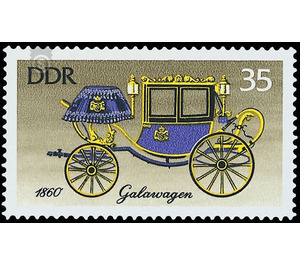Historic carriages - Germany / German Democratic Republic 1976 - 35 Pfennig
Theme: Post & Philately
| Country | Germany / German Democratic Republic |
| Issue Date | 1976 |
| Face Value | 35.00 |
| Color | brown |
| Perforation | K 14 |
| Printing Type | Rotogravure 2 |
| Stamp Type | Postage stamp |
| Item Type | Stamp |
| Chronological Issue Number | 1892 |
| Chronological Chapter | GER-DDR |
| SID | 710836 |
| In 22 Wishlists | |
Historic carriages The Ministry of Posts and Telecommunications of the German Democratic Republic issues six multicolored special postage stamps depicting historical carriages. Historic Carriages Four of the originals of the designs in this issue (10, 20, 35 and 50 Pfennig values) are in the collection of carriages of the museums in the castle of Augustusburg (Karl-Marx-Stadt district). The Kalesche on the 25-pfennig value is part of the stock of art collections in Weimar and the model of the stagecoach on the 40-pfennig value is in the collections of the postal museum of the GDR in Berlin. In the age of spaceships, airplanes and automobiles, the coach has almost completely disappeared from the horizon of today's generation as a means of transporting people and can usually only be admired as a "museum piece". While four-wheeled wagons were already known as work and load transport equipment in antiquity, the traces of the emergence of carriages can only be traced back to the 16th century. At that time, however, the use of carriages was a privilege of the high feudal nobility, and there was hardly a princely court in Europe that lacked city carriages and ceremonial carriages. However, the carriages issued in the castle Augustusburg come from a later construction period and belonged largely to the inventory of the former Royal Marstall in Dresden. After 1945 they were saved from further decay, transferred to Augustusburg and preserved and restored here with considerable state resources. On the 35-pfennig value a galawagen is shown, which was built around 1860 by the Dresden court saddler H. BÜRGER for the Saxon royal court. The black-blue and gold-decorated car body is - in the usual way - hung by strong leather straps in C-springs. The carriage was driven by four horse and served in 1886 as a wedding carriage of the Princess Maria Josepha and the Archduke Otto.


